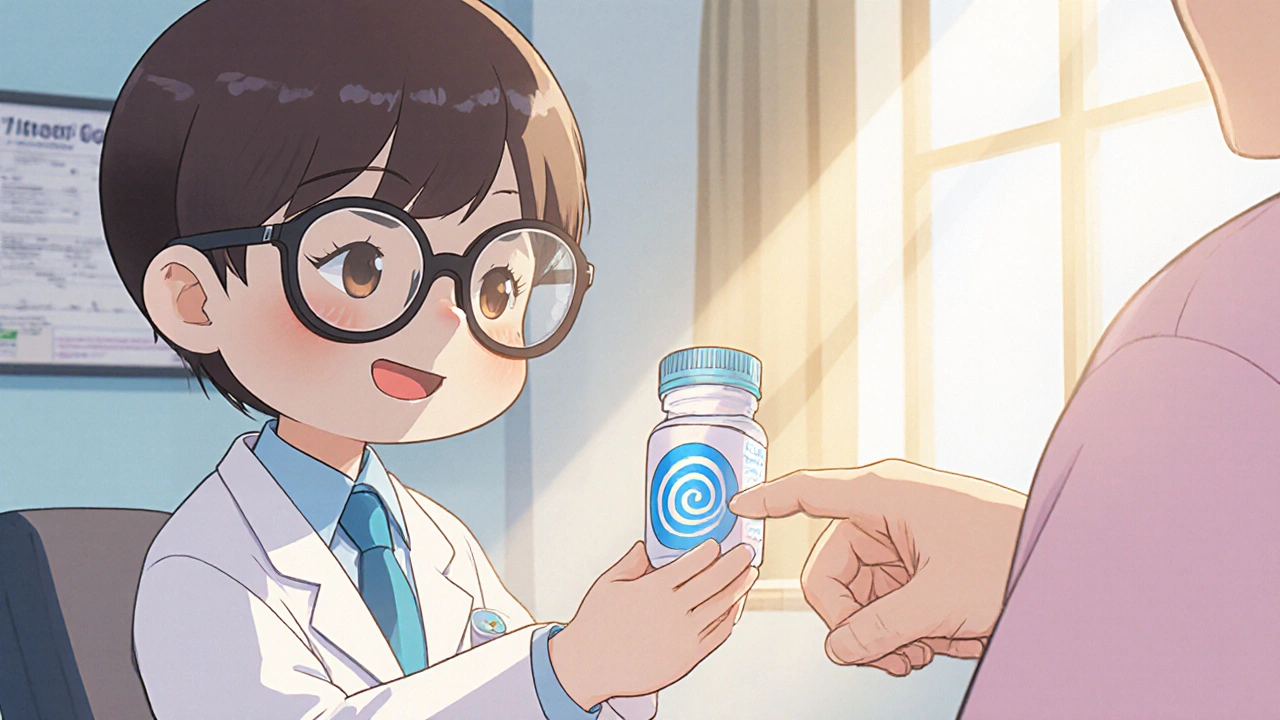Diuretic Selection Guide
Diuretic Selection Tool
This tool helps determine the most appropriate diuretic based on patient characteristics and medical conditions. Select the options that best match your patient's situation to get a recommendation.
When your doctor prescribes a pill to lower blood pressure or reduce fluid retention, chances are you’ll see the name Hydrochlorothiazide on the label. But it’s not the only game in town. Understanding how it stacks up against other diuretics can help you avoid side‑effects, keep your BP in range, and stay on top of lab results.
What is Hydrochlorothiazide?
Hydrochlorothiazide is a thiazide‑type diuretic that promotes sodium and water excretion by inhibiting the Na⁺/Cl⁻ symporter in the distal convoluted tubule. It’s been a first‑line choice for essential hypertension since the 1960s and is also used for mild‑to‑moderate edema. Typical oral doses range from 12.5 mg to 50 mg once daily, and the drug’s half‑life of 6-15 hours means a single dose usually covers a whole day.
How Hydrochlorothiazide Lowers Blood Pressure
The drug’s primary action reduces plasma volume, which in turn lowers cardiac output. Over weeks, the body adjusts by decreasing peripheral vascular resistance, giving a sustained BP drop of about 8-10 mm Hg systolic. Because the effect builds gradually, doctors often start with a low dose and titrate up while checking electrolytes.
Key Alternatives to Hydrochlorothiazide
Not everyone tolerates thiazides well. Below are the most common substitutes, each with its own strengths and weaknesses.
- Chlorthalidone is a long‑acting thiazide‑like diuretic that works farther down the nephron, offering a more potent natriuretic effect.
- Indapamide blends thiazide action with vasodilation, making it useful for isolated systolic hypertension.
- Furosemide belongs to the loop‑diuretic class; it’s the go‑to drug for rapid diuresis in heart failure or acute renal edema.
- Spironolactone is a potassium‑sparing diuretic that antagonizes aldosterone, ideal for resistant hypertension and hyperaldosteronism.
- Thiazide diuretics as a class encompass Hydrochlorothiazide, Chlorthalidone, and Indapamide, sharing a common mechanism but differing in potency and duration.
Side‑Effect Profile Across the Board
All diuretics can stir up electrolyte imbalances, but the pattern varies.
- Thiazides (Hydrochlorothiazide, Chlorthalidone, Indapamide) → hypokalemia, hyponatremia, hyperuricemia.
- Loop diuretics (Furosemide) → more pronounced potassium loss, ototoxicity at high doses.
- Potassium‑sparing agents (Spironolactone) → hyperkalemia, especially when combined with ACE inhibitors.
Awareness of these trends guides lab monitoring schedules.

Head‑to‑Head Comparison Table
| Drug | Class | Typical Daily Dose | Duration of Action | Main Advantages | Common Drawbacks |
|---|---|---|---|---|---|
| Hydrochlorothiazide | Thiazide | 12.5-50 mg | 6-15 h | Well‑studied, inexpensive, once‑daily dosing | May cause low potassium, less potent than chlorthalidone |
| Chlorthalidone | Thiazide‑like | 12.5-25 mg | 24-48 h | Longer acting, greater BP reduction per mg | Higher risk of metabolic side effects, not always covered by insurers |
| Indapamide | Thiazide‑like | 1.5 mg SR | 12-24 h | Less impact on glucose and lipids, good for isolated systolic HTN | Limited availability in some regions |
| Furosemide | Loop | 20-80 mg (dose‑dependent) | 2-6 h | Powerful diuresis, useful in acute fluid overload | Frequent dosing, ototoxicity at high doses, potassium loss |
| Spironolactone | Potassium‑sparing | 25-100 mg | 24 h | Addresses aldosterone‑mediated hypertension, protects kidneys | Risk of hyperkalemia, menstrual irregularities in women |
When Hydrochlorothiazide Is the Right Pick
If you need a low‑cost, once‑daily pill for uncomplicated primary hypertension, Hydrochlorothiazide remains a solid first choice. It works well alongside ACE inhibitors or ARBs, and many formularies list it as a preferred drug. Ideal candidates are patients with:
- Normal baseline potassium and renal function
- No history of gout (because thiazides raise uric acid)
- No significant metabolic syndrome concerns
Scenarios Where an Alternative May Perform Better
Real‑world practice reveals several gray zones.
- Resistant hypertension: Adding Spironolactone often brings the BP down when three drugs fail.
- Chronic kidney disease stage 3‑4: Chlorthalidone provides a longer‑acting effect, reducing pill burden.
- Patients prone to gout: Indapamide has a milder impact on uric acid.
- Acute pulmonary edema: Furosemide delivers rapid fluid removal.

Practical Tips for Switching or Combining Diuretics
- Check baseline electrolytes (Na⁺, K⁺, Mg²⁺) and renal function (eGFR).
- If moving from Hydrochlorothiazide to Chlorthalidone, reduce the new dose by roughly half the Hydrochlorothiazide dose (e.g., 25 mg HCTZ → 12.5 mg chlorthalidone).
- When adding a potassium‑sparing agent, schedule an extra potassium check at 2 weeks and again at 1 month.
- Educate patients on symptoms of low potassium (muscle cramps, irregular heartbeat) and high potassium (fatigue, tingling).
- Document any drug‑drug interactions, especially with NSAIDs, lithium, or digoxin.
Monitoring Schedule Overview
Regular labs keep you safe.
| Time Frame | Lab Tests | Notes |
|---|---|---|
| Baseline | Serum electrolytes, creatinine, uric acid, fasting glucose | Establish reference values. |
| 2 weeks after initiation or dose change | Electrolytes, creatinine | Identify early imbalances. |
| 3 months | Full metabolic panel | Assess chronic effects. |
| Every 6‑12 months thereafter | Electrolytes + renal function | Routine surveillance. |
Bottom Line Checklist
- Start with Hydrochlorothiazide for uncomplicated hypertension.
- Switch to Chlorthalidone or Indapamide if you need longer action or have gout risk.
- Reserve Furosemide for rapid fluid removal, not long‑term BP control.
- Consider Spironolactone for resistant hypertension or aldosterone excess.
- Never skip electrolyte checks; a simple blood draw prevents serious complications.
Frequently Asked Questions
Can I take Hydrochlorothiazide and a potassium supplement together?
Yes, many clinicians pair a thiazide with a low‑dose potassium chloride to offset hypokalemia. The supplement should be taken in the evening, and electrolytes need checking after two weeks.
Why does Hydrochlorothiazide sometimes raise blood sugar?
Thiazides can increase insulin resistance by promoting sodium retention in muscle cells. The effect is modest, but patients with pre‑diabetes should have fasting glucose monitored quarterly.
Is Chlorthalidone more effective than Hydrochlorothiazide?
Clinical trials show Chlorthalidone reduces systolic BP about 2‑3 mm Hg more than an equal‑dose Hydrochlorothiazide, likely due to its longer half‑life and stronger natriuretic action.
Can I switch from Hydrochlorothiazide to Indapamide without a wash‑out period?
Yes. Because both are thiazide‑like, you can overlap the last dose of Hydrochlorothiazide with the first dose of Indapamide for a day, then discontinue the former.
What should I do if I experience frequent urination at night?
Take your diuretic dose in the morning. If nocturia persists, your doctor may lower the dose or switch to a longer‑acting agent that blunts the peak diuretic effect.

Comments (15)
Ekeh Lynda
October 24, 2025 AT 16:23
Hydrochlorothiazide has been a cornerstone drug for decades. Its mechanism relies on blocking the sodium chloride symporter in the distal tubule. By reducing sodium reabsorption the drug forces the kidneys to excrete more water. The net effect is a modest drop in plasma volume. The body compensates over weeks by lowering vascular resistance. This dual action explains the consistent blood pressure reduction seen in trials. Compared with chloro thalidone the half life is shorter. Chloro thalidone can stay active for up to two days. That longer exposure translates into better control for some patients. However the extended action also brings a higher risk of electrolyte swings. Patients on hydrochlorothiazide should have potassium checked after two weeks. If hypokalemia appears a low dose potassium supplement can be added. The drug is inexpensive and widely covered by insurers. Its affordability makes it attractive for primary care settings. Nevertheless clinicians must weigh gout risk because thiazides raise uric acid. In patients with pre‑diabetes the drug may modestly increase glucose levels. Overall the choice between hydrochlorothiazide and its alternatives depends on individual comorbidities and cost considerations.
Dawn Bengel
October 25, 2025 AT 14:37
This guide shows why American doctors get the best diuretic protocols 😂
junior garcia
October 26, 2025 AT 11:52
I appreciate the thorough breakdown. It really helps patients understand why a doctor might choose one pill over another. The clarity makes the medical jargon less intimidating. Keep the info coming.
Dason Avery
October 27, 2025 AT 10:07
What a solid rundown! 🌟 The tables make the differences crystal clear. I love how you note the cost factor – that matters to a lot of us. The practical tips on lab monitoring are gold. Definitely sharing this with my clinic mates.
Kester Strahan
October 28, 2025 AT 08:21
Yo the ndurataion thing is key. HCTZ peaks fast while chloro hits the long game. If you need steady natriuresis go with chloro. Also watch uric acid spikes – they can turn gout on fast. The loop fam like furosemide still rules acute edems.
Doreen Collins
October 29, 2025 AT 06:36
Great post! I especially like the step‑by‑step switching guide. It removes a lot of guesswork for clinicians. The reminder about potassium supplements is spot on. Also, the note on gout risk saved me a bad reaction last year. Thanks for making the science so accessible.
HILDA GONZALEZ SARAVIA
October 30, 2025 AT 04:51
Thanks for the practical advice. I’ve been hesitant to swap drugs because of dosing confusion. Your half‑dose rule makes the transition feel safer. I’ll definitely run the extra potassium check as you suggest.
Lindy Hadebe
October 31, 2025 AT 03:05
The article is thorough but seems to favor cheap options. Not all patients can tolerate thiazides.
Tammy Watkins
November 1, 2025 AT 01:20
I must stress that while cost is important, patient safety comes first. Those with borderline renal function may benefit from the longer‑acting chloro thalidone despite higher price. Moreover, the risk of metabolic derangements should not be downplayed. In resistant cases, adding a potassium‑sparing agent like spironolactone often yields the best outcome. Your checklist covers these points well, though I would add a note on patient education.
Casey Morris
November 1, 2025 AT 23:35
Interesting, very detailed, and-let's be honest-quite dense, you know?, but the tables really help, and the emphasis on labs is crucial, especially for those who forget to order follow‑ups, also the side‑effect breakdown is spot‑on, great work!
Teya Arisa
November 2, 2025 AT 21:49
Thank you for this comprehensive guide 😊 It will be a handy reference for my patients when discussing medication options. The clear lab schedule is especially useful. Looking forward to more posts like this.
Carla Taylor
November 3, 2025 AT 20:04
Glad it helped! The concise format makes it easy to share with anyone.
Kathryn Rude
November 4, 2025 AT 18:19
While the data is solid the tone feels a bit condescending. Readers might appreciate a more balanced voice. Still, the facts are right and the tables are useful. Keep it up :)
Mary Mundane
November 5, 2025 AT 16:33
The comparison could use more real‑world anecdotes.
Michelle Capes
November 6, 2025 AT 14:48
I found the electrolyte reminder super helpful 😊 My only worry is the typo in "hydroclorothiazide" but overall great info!